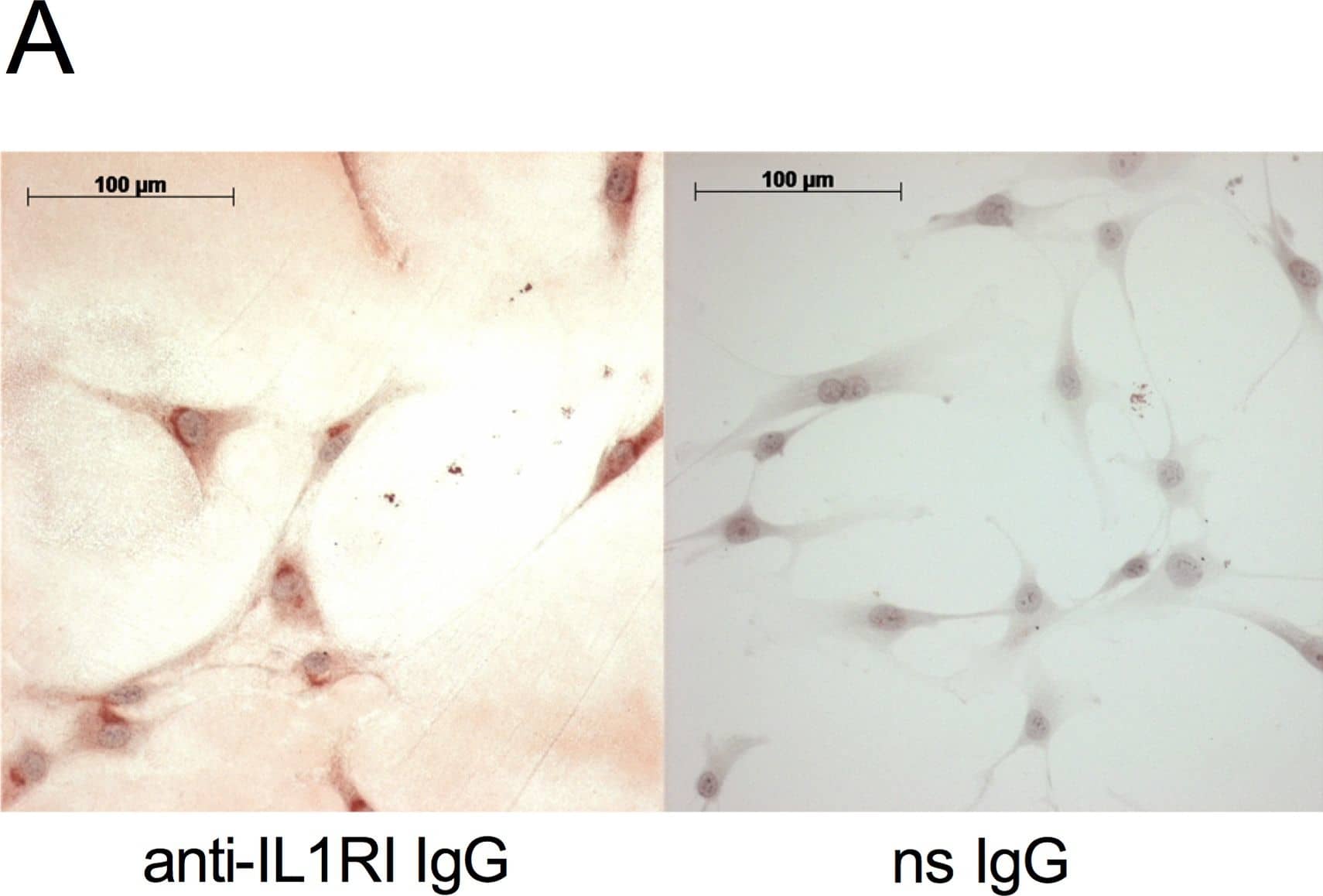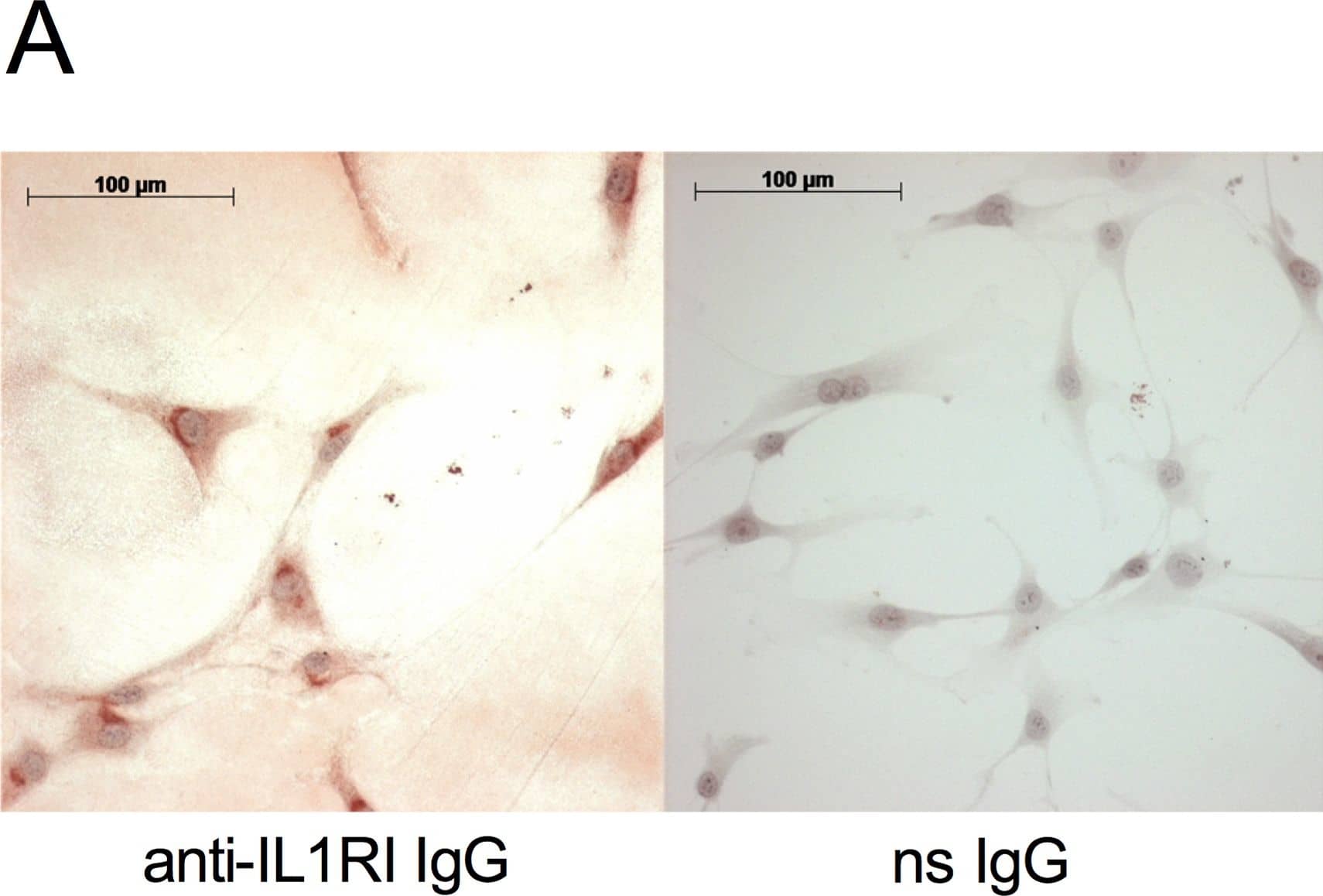Human IL-1 RI Antibody
R&D Systems, part of Bio-Techne | Catalog # AF269

Key Product Details
Species Reactivity
Validated:
Cited:
Applications
Validated:
Cited:
Label
Antibody Source
Product Specifications
Immunogen
Specificity
Clonality
Host
Isotype
Endotoxin Level
Scientific Data Images for Human IL-1 RI Antibody
Detection of IL-1 RI in HUVEC Human Cells by Flow Cytometry.
HUVEC human umbilical vein endothelial cells were labeled with Human IL-1 RI Antigen Affinity-purified Polyclonal Antibody (Catalog # AF269, filled histogram) or control antibody (Catalog # AB-108-C, open histogram), followed by Phycoerythrin-conjugated Anti-Goat IgG Secondary Antibody (Catalog # F0107).CXCL1/GRO alpha Secretion Induced by IL‑1 beta/IL‑1F2 and Neutralization by Human IL‑1 RI Antibody.
Recombinant Human IL-1 beta/IL-1F2 (Catalog # 201-LB) induces CXCL1/GROa secretion in the HT-29 human colon adenocarcinoma cell line in a dose-dependent manner (orange line),as measured by the Human CXCL1/GROa DuoSet (Catalog # DY275). CXCL1/GROa secretion elicited by Recombinant Human IL-1 beta/IL-1F2 is neutralized (green line) by increasing concentrations of Human IL-1 RI Antigen Affinity-purified Polyclonal Antibody (Catalog # AF269). The ND50 is typically < 5 µg/mL in the presence of 400 pg/mL Recombinant Human IL-1 beta/IL-1F2.Detection of Human IL-1 RI by Immunocytochemistry/ Immunofluorescence
Expression of IL1RI in native MSC and inhibition of the IL1beta mediated regulation of gene expression in PTC or IL1beta stimulated MSC.A) MSC on glass slides were stained with an anti-IL1RI antibody (left) or the non-specific IgG isotype control (right). Gene expression levels of B) PTGES, C) TSG6 and F) MMP1 were measured with quantitative real-time PCR and normalized to those of HPRT1 following total RNA isolation 24 h post stimulation. D) PGE2 and E) TSG6 levels in supernatants were detected with the Biotrend PGE2 Enzyme Immunoassay Kit and TSG6 ELISA. MSC were seeded at 5.2*103 cells/cm2 and stimulated with the PTC or IL1beta after the anti-IL1RI antibody or the non-specific (ns) IgG isotype control had been added. Scatter plots and mean from up to 4 donors are presented. Image collected and cropped by CiteAb from the following open publication (https://dx.plos.org/10.1371/journal.pone.0116772), licensed under a CC-BY license. Not internally tested by R&D Systems.Applications for Human IL-1 RI Antibody
CyTOF-ready
Flow Cytometry
Sample: HUVEC human umbilical vein endothelial cells
Western Blot
Sample: Recombinant Human IL‑1 RI
Neutralization
Reviewed Applications
Read 2 reviews rated 4.5 using AF269 in the following applications:
Formulation, Preparation, and Storage
Purification
Reconstitution
Formulation
Shipping
Stability & Storage
- 12 months from date of receipt, -20 to -70 °C as supplied.
- 1 month, 2 to 8 °C under sterile conditions after reconstitution.
- 6 months, -20 to -70 °C under sterile conditions after reconstitution.
Background: IL-1 RI
Two distinct types of receptors that bind the pleiotropic cytokines IL-1 alpha and IL-1 beta have been described. The IL-1 receptor Type I is an 80 kDa transmembrane protein that is expressed predominantly by T cells, fibroblasts, and endothelial cells. IL-1 receptor Type II is a 68 kDa transmembrane protein found on B lymphocytes, neutrophils, monocytes, large granular leukocytes and endothelial cells. Both receptors are members of the immunoglobulin superfamily and show approximately 28% sequence identity in their extracellular domains. The two receptor types do not heterodimerize into a receptor complex.
An IL-1 receptor accessory protein that can heterodimerize with the Type I receptor in the presence of IL-1 alpha or IL-1 beta but not IL-1ra, was identified (1). This Type I receptor complex appears to mediate all the known IL-1 biological responses. The receptor Type II has a short cytoplasmic domain and does not transduce IL-1 signals. In addition to the membrane-bound form of IL-1 RII, a naturally-occurring soluble form of IL-1 RII has been described. It has been suggested that the Type II receptor, either as the membrane-bound or as the soluble form, serves as a decoy for IL-1 and inhibits IL-1 action by blocking the binding of IL-1 to the signaling Type I receptor complex. Recombinant IL-1 soluble receptor Type I is a potent antagonist of IL-1 action.
References
- Greenfeder, S. et al. (1995) J. Biol. Chem. 270:13757.
Long Name
Alternate Names
Gene Symbol
Additional IL-1 RI Products
Product Documents for Human IL-1 RI Antibody
Product Specific Notices for Human IL-1 RI Antibody
For research use only



